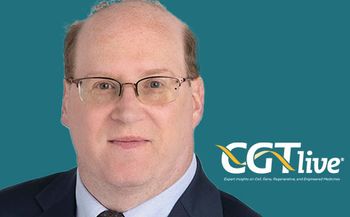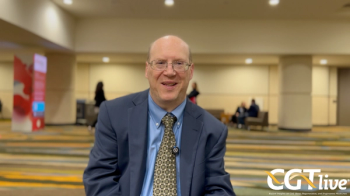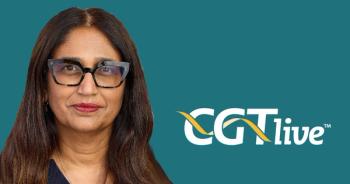
Expert Excited for Next Steps With CAR-T in Non-Hodgkin Lymphoma
Ahmed Galal, MD, sheds light on the current use of CAR T-cell therapy in relapsed/refractory lymphomas and a handful of strategies to expand the reach of this therapy.
Ahmed Galal, MD
The FDA approval of 2 CAR T-cell therapies to treat select patients with aggressive non-Hodgkin lymphoma (NHL) subtypes has filled a significant unmet need in the third-line setting. Still, certain obstacles are preventing this treatment from becoming more universally utilized, said Ahmed Galal, MD.
Because of the complex administration of this form of therapy, CAR T cells are still primarily offered at academic institutions and centers. Galal, an instructor in the Department of Medicine, Duke Cancer Institute, anticipates that a more readily accessible form of CAR T-cell therapy utilizing natural killer (NK) cells could help broaden this field in the foreseeable future.
In addition, the adverse events (AEs) associated with CAR T-cell therapy, particularly cytokine release syndrome (CRS) and neurotoxicity, can be daunting. Galal noted that early administration of steroids right at the onset of CRS can help combat its severity.
“Using the steroids more without fear makes a difference,” noted Galal. “It doesn't decrease the incidence of the neurotoxicity but definitely the intensity.”
Regarding the available therapies, axicabtagene ciloleucel (axi-cel; Yescarta) is approved by the FDA as a treatment for adults with relapsed or refractory large B-cell lymphoma after 2 or more lines of systemic therapy. Moreover, tisagenlecleucel (Kymriah) is indicated for adult patients with relapsed/refractory large B-cell lymphoma—including diffuse large B-cell lymphoma (DLBCL), high-grade B-cell lymphoma, and DLBCL arising from follicular lymphoma—after ≥2 lines of systemic therapy.
In an interview during the 2019 OncLive® State of the Science Summit™ on Hematologic Malignancies, Galal shed light on the current use of CAR T-cell therapy in relapsed/refractory lymphomas and a handful of strategies to expand the reach of this therapy.
OncLive®: What activity have we seen with the FDA-approved CAR T-cell therapies?
Galal: Currently, CAR T cells are approved in the aggressive lymphomas: DLBCL, transformed lymphoma, primary mediastinal large B-cell lymphoma, and in high-grade lymphoma not otherwise specified. This is a big population and is probably the big bulk of NHL. These patients would usually have frontline therapy, then they would fail it, and acquire a second-line therapy. Once they are resistant to 2 lines of therapy, they would qualify for CAR T-cell therapy as a third-line treatment.
I would say that at least 40% of patients who get treated with frontline therapy will relapse, whether they are treated with R-CHOP [rituximab (Rituxan), cyclophosphamide, doxorubicin, vincristine, and prednisone] or R-EPOCH [rituximab, etoposide phosphate, prednisone, vincristine sulfate, cyclophosphamide, and doxorubicin hydrochloride]. Of the 40% of patients with DLBCL who relapse, only 30% would make it to transplant. This means that patients don't respond very well to second-line therapy.
If we're looking at the SCHOLAR-1 data, or other studies, we would find about 74% of patients are resistant to second-line therapy. Therefore, there is an unmet need in this population, and CAR T-cell therapy came and was very helpful in adding new hope for patients with relapsed/refractory disease.
What are the next steps with CAR T-cell therapy?
Number one, in my opinion, looking at the real-world setting, we need to identify patients better. I'll give you an example: we have about 12,000 patients in the United States with relapsed/refractory lymphomas who are eligible for CAR T-cell therapy, but we have only treated about 1000 so far. We are definitely undertreating with this modality. Therefore, we need to identify and refer patients earlier for [this approach].
Secondly, the financial barriers for Medicare patients, for instance, is a huge obstacle. Being in the United States, everyone expects “equal opportunity for everyone,” but that's not the case [with this therapy]. We hope to address this soon.
The third thing is the optimization of the response from CAR T-cell therapy for the patients who relapse quickly with this therapy. Finding the right treatment for these patients is key. Also, the AEs [are a challenge]. We frequently see CRS or neurotoxicity, so working on these AEs will make this treatment more optimal.
Is it possible to get more centers educated on CAR T-cell administration?
Currently, because of the experience with cellular therapy and transplant, most of these institutions are from academic centers. Eventually, what's going to happen is we will have off-the-shelf CAR T cells with NK cells. That could be available for any patient when they are fitting the indication. This is a few years ahead.
Right now, we should still stick with experienced centers as the authorized centers, because handling the cells and managing the manipulation of the cells requires expertise. You want this treatment to be successful, so you have to optimize the situation around the cells. We will eventually see off-the-shelf CAR T cells, and there are ongoing trials looking at this.
What makes these off-the-shelf products different?
The difference with using something NK cells that link to CD19 is that NK cells don't require human leukocyte antigens matching. You'll find it's available for anyone with healthy cells. Therefore, if someone meets the indication for CAR T-cell therapy, they would have these cells infused and hopefully be successful. There is ongoing research looking at the safety and efficacy of these cell lines.
How can physicians become better educated on management of AEs linked with CAR T-cell therapy?
To tell you the truth, at the beginning of the CAR T-cell therapy era, we were all very worried about the AEs and how we treat them. We knew we had to use steroids, and we all know that steroids can affect the CAR T cells by decreasing their activity. Therefore, we were really stingy about using steroids early on. We have found more opportunities to use the steroids earlier and to treat these patients when they have early signs of CRS. We [would still likely] discover it at the grade II level. That kind of awareness and comfort will change the field toward less grade 3/4 neurotoxicity.
The other thing is working on the product itself and looking at ways to decrease CRS and neurotoxicity. Currently, having an “on and off switch” for CAR T-cell therapy is in the works.
Newsletter
Stay at the forefront of cutting-edge science with CGT—your direct line to expert insights, breakthrough data, and real-time coverage of the latest advancements in cell and gene therapy.

















































